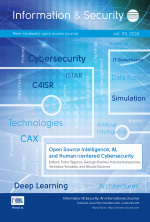Command and Control in Crisis Management
Source:
Information & Security: An International Journal,Keywords:
bio-terrorism, C2 principles, chemical weapons, civil-military cooperation, homeland defense, Military command and control systems, standardAbstract:
In the light of the recent terrorism and the beginnings of what will likely be a long war involving many attacks on this country, it is time that we think of command and control systems that are capable of being extended to the civilian components which will ultimately be working with and alongside military forces. Command and control systems gather information from increasingly smaller sized units, and also from a wider variety of types of organizations and systems. This is reflected in new data elements which themselves reflect new types and capabilities of military and civilian units and equipment. All that is required is the will to extend and unify command and control. Perhaps the new office of Homeland Defense can define the framework in which military command and control can be extended to civil agencies and organizations and help define the nature and extent of data standardization that will allow for independent yet coordinated development. The Global Command and Control System (GCCS) is an example of one command and control system that could be of value. An unclassified version of this system could be set up with special attention to unclassified data exchange which would allow senior military commanders to view civil response units and at the same time release similar information to appropriate civil authority thereby aiding in planning. The paper also provide a glimpse on the challenges of bio-terrorism.
